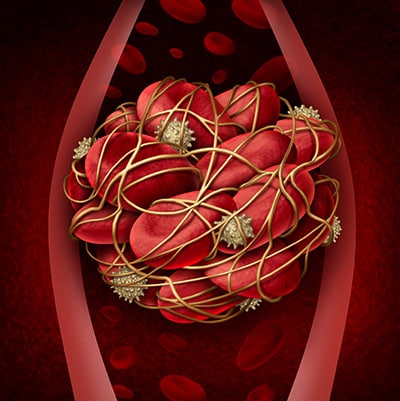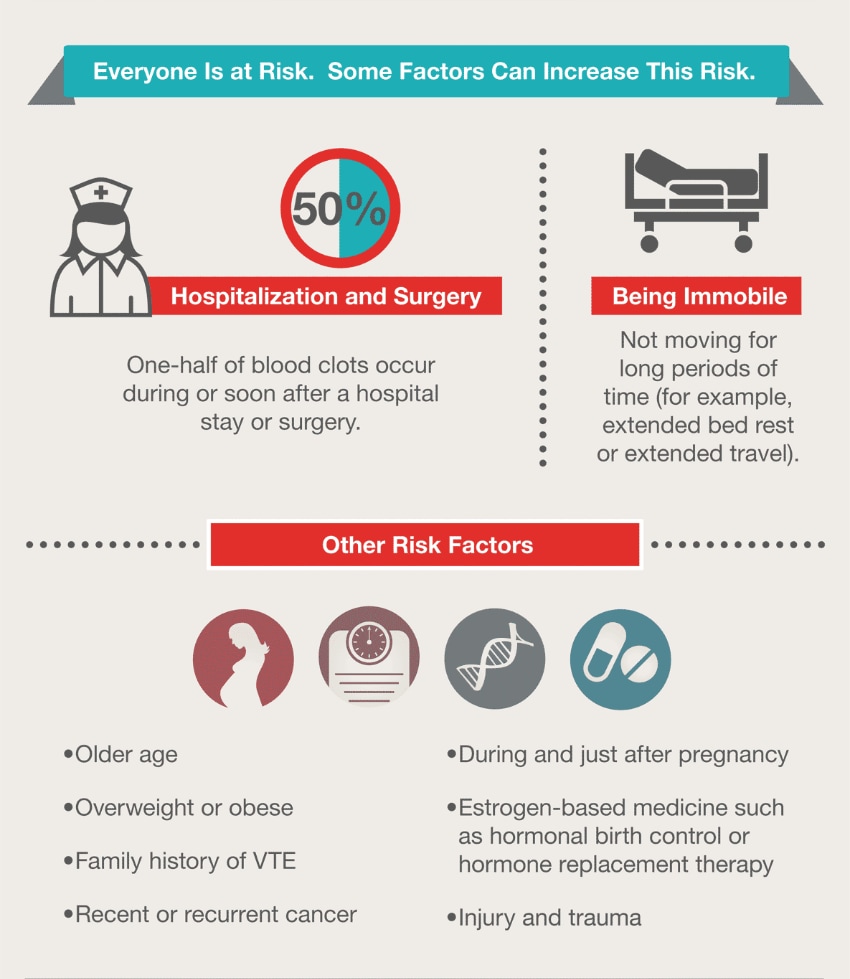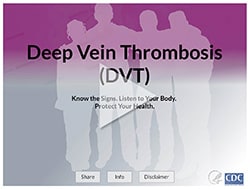
What is Venous Thromboembolism?

Deep Vein Thrombosis and Pulmonary Embolism (DVT/PE) are often underdiagnosed and serious, but preventable medical conditions.
Deep vein thrombosis (DVT) is a medical condition that occurs when a blood clot forms in a deep vein. These clots usually develop in the lower leg, thigh, or pelvis, but they can also occur in the arm.
It is important to know about DVT because it can happen to anybody and can cause serious illness, disability, and in some cases, death. The good news is that DVT is preventable and treatable if discovered early.
New Clinical Practice Guidelines for Venous Thromboembolism
Venous thromboembolism (VTE), a term referring to blood clots in the veins, is an underdiagnosed and serious, yet preventable medical condition that can cause disability and death.
The American Society of Hematology (ASH) recognizes the need for a comprehensive set of guidelines on the treatment of VTE to help the medical community better manage this serious condition. In partnership with the McMaster University GRADE Centre, ASH brought together experts to address this challenge, including hematologists, other clinicians, guideline development specialists, and patient representatives. In November 2018, ASH announced the results of their collective efforts – the 2018 ASH Clinical Practice Guidelines on Venous Thromboembolism. Access the new guidelines.
Complications of DVT
The most serious complication of DVT happens when a part of the clot breaks off and travels through the bloodstream to the lungs, causing a blockage called pulmonary embolism (PE). If the clot is small, and with appropriate treatment, people can recover from PE. However, there could be some damage to the lungs. If the clot is large, it can stop blood from reaching the lungs and is fatal.
In addition, one-third to one-half of people who have a DVT will have long-term complications caused by the damage the clot does to the valves in the vein called post-thrombotic syndrome (PTS). People with PTS have symptoms such as swelling, pain, discoloration, and in severe cases, scaling or ulcers in the affected part of the body. In some cases, the symptoms can be so severe that a person becomes disabled.
For some people, DVT and PE can become a chronic illness; about 30% of people who have had a DVT or PE are at risk for another episode.
Risk Factors for DVT
Almost anyone can have a DVT. However, certain factors can increase the chance of having this condition. The chance increases even more for someone who has more than one of these factors at the same time.
Following is a list of factors that increase the risk of developing DVT:
- Injury to a vein, often caused by:
- Fractures,
- Severe muscle injury, or
- Major surgery (particularly involving the abdomen, pelvis, hip, or legs).
- Slow blood flow, often caused by:
- Confinement to bed
(e.g., due to a medical condition or after surgery); - Limited movement (e.g., a cast on a leg to help heal an injured bone);
- Sitting for a long time, especially with crossed legs; or
- Paralysis.
- Confinement to bed
- Increased estrogen, often caused by:
- Birth control pills
- Hormone replacement therapy, sometimes used after menopause
- Pregnancy, for up to 3 months after giving birth
- Certain chronic medical illnesses, such as:
- Heart disease
- Lung disease
- Cancer and its treatment
- Inflammatory bowel disease (Crohn’s disease or ulcerative colitis)
- Other factors that increase the risk of DVT include:
- Previous DVT or PE
- Family history of DVT or PE
- Age (risk increases as age increases)
- Obesity
- A catheter located in a central vein
- Inherited clotting disorders
Preventing DVT

The following tips can help prevent DVT:
- Move around as soon as possible after having been confined to bed, such as after surgery, illness, or injury.
- If you’re at risk for DVT, talk to your doctor about:
- Graduated compression stockings (sometimes called “medical compression stockings”)
- Medication (anticoagulants) to prevent DVT.
- When sitting for long periods of time, such as when traveling for more than four hours:
- Get up and walk around every 2 to 3 hours.
- Exercise your legs while you’re sitting by:
- Raising and lowering your heels while keeping your toes on the floor
- Raising and lowering your toes while keeping your heels on the floor
- Tightening and releasing your leg muscles
- Wear loose-fitting clothes.
- You can reduce your risk by maintaining a healthy weight, avoiding a sedentary lifestyle, and following your doctor’s recommendations based on your individual risk factors.
Symptoms
Know the Signs. Know your Risk. Seek Care.
Everybody should know the signs and symptoms of DVT/PE, their risk for DVT/PE, to talk to their health care provider about their risk, and to seek care immediately if they have any sign or symptom of DVT/PE.
DVT
Downloadable slideshow on DVT
This narrated slideshow describes the risk factors, signs, and symptoms of DVT/PE.
About half of people with DVT have no symptoms at all. The following are the most common symptoms of DVT that occur in the affected part of the body:
- Swelling
- Pain
- Tenderness
- Redness of the skin
If you have any of these symptoms, you should see your doctor as soon as possible.
PE
You can have a PE without any symptoms of a DVT.
Signs and symptoms of PE can include:
- Difficulty breathing
- Faster than normal or irregular heart beat
- Chest pain or discomfort, which usually worsens with a deep breath or coughing
- Coughing up blood
- Very low blood pressure, lightheadedness, or fainting
If you have any of these symptoms, you should seek medical help immediately.
Diagnosis of DVT and PE
The diagnosis of DVT or PE requires special tests that can only be performed by a doctor. That is why it is important for you to seek medical care if you experience any of the symptoms of DVT or PE.
Treatments for DVT and PE
DVT
Medication is used to prevent and treat DVT. Compression stockings (also called graduated compression stockings) are sometimes recommended to prevent DVT and relieve pain and swelling. These might need to be worn for 2 years or more after having DVT. In severe cases, the clot might need to be removed surgically.
PE
Immediate medical attention is necessary to treat PE. In cases of severe, life-threatening PE, there are medicines called thrombolytics that can dissolve the clot. Other medicines, called anticoagulants, may be prescribed to prevent more clots from forming. Some people may need to be on medication long-term to prevent future blood clots.
Did you know?
DVT does not cause heart attack or stroke. There are two main types of blood clots.
How a clot affects the body depends on the type and location of the clot:
How a clot affects the body depends on the type and location of the clot:
- A blood clot in a deep vein of the leg, pelvis, and sometimes arm, is called deep vein thrombosis (DVT). This type of blood clot does not cause heart attack or stroke.
- A blood clot in an artery, usually in the heart or brain, is called arterial thrombosis. This type of blood clot can cause heart attack or stroke.
Both types of clots can cause serious health problems, but the causes and steps you can take to protect yourself are different. To learn more about arterial thrombosis, visit CDC’s information about heart disease and stroke prevention.























.png)












No hay comentarios:
Publicar un comentario